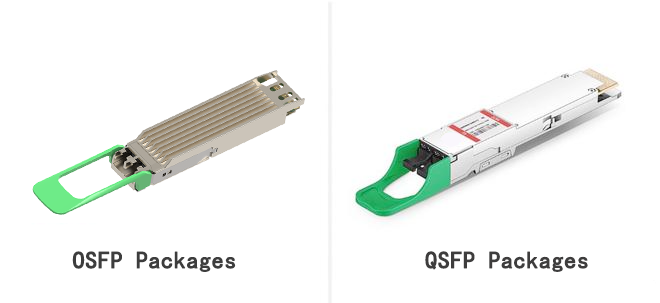

 Knowledge Base +
Knowledge Base +  2024.08.27
2024.08.27What form-factors are used for 800G transceivers?
800G transceivers utilize the same form factors as 400G optics, namely the OSFP and QSFP-DD. Walsun offers support for both form factors, providing 800G platforms in OSFP and QSFP-DD variants.

OSFP: The OSFP, which stands for "Octal Small Form-factor Pluggable," is named "Octal" because its electrical interface consists of 8 electrical lanes. In the case of 800G, each electrical lane is modulated at 100Gb/s, resulting in a total bandwidth of 800Gb/s.
QSFP-DD: The QSFP-DD, which stands for "Quad Small Form-factor Pluggable - Double Density," shares a similar form factor with the QSFP but features an additional row of electrical contacts to accommodate more high-speed electrical lanes. While a QSFP has 4 high-speed electrical lanes, a QSFP-DD has 8. In the context of 800G, each electrical lane of the QSFP-DD operates at 100Gb/s, providing a total bandwidth of 800Gb/s.
OSFP 8x100G SR8 transceiver modules are designed for 800 Gigabit Ethernet links over 60m OM3 or 100m OM4 fiber. The module has 8 independent channels of electrical input/output, each operating at up to 106.25Gbps. The transceiver consists of two transmitter/receiver units, each operating at 850nm wavelength.
| FiberMall P/N | OSFP-800G-SR8 | Vendor Name | FiberMall |
| Form Factor | OSFP | Max Data Rate | 850Gbps(8x 106.25Gbps) |
| Wavelength | 850nm | Max Distance | 60m on OM3/100m on OM4 |
| Modulation Format | PAM4 | Host Required | FEC |
| Connector | MTP/MPO-16 | Voltage Supply | 3.3V |
| Cable Type | MMF | DDM Support | Yes |
| Transmitter Type | 850nm VCSEL | Receiver Type | PIN |
| TX Power | -4.6~+4.0dBm | Receiver Sensitivity | < -4.6dBm |
| Operation Temperature | 0 to 70°C (32 to 158°F) | Maximum Power | < 15W |
| Protocols | CMIS Rev 5.0, IEEE P802.3ck and IEEE 802.3cu | Application | 800G Ethernet, Data Center Interconnect, Infiniband Interconnects |
800G Optical Module Q&A
Q:Can OSFP optical modules be inserted into QSFP-DD ports? Can QSFP-DD be inserted into OSFP ports?
A:No, they cannot. OSFP and QSFP-DD are two different form factors with distinct physical sizes. OSFP systems must use OSFP optical modules and cables, while QSFP-DD systems must use QSFP-DD optical modules and cables.
Q:How many electrical lanes does an 800G optical module use?
An 800G optical module uses 8 electrical lanes for data transmission, with each lane having a receive channel and a transmit channel.
Q:What is the data rate and modulation format used by 800G OSFP/QSFP-DD modules?
A:As previously mentioned, all 800G optical modules utilize 8 electrical lanes for bidirectional transmission, with each lane having a receive channel and a transmit channel. The data transmission rate for each lane is 100Gb/s, resulting in a total bandwidth of 800Gb/s for the module. Additionally, the optical output of 800G modules is composed of 8 optical wavelengths, with each wavelength utilizing 100G PAM4 modulation per lane.
Q:What is the significance of using PAM4 modulation in 800G optical modules for digital signal transmission?
A:800G optical modules employ PAM4 modulation, which enhances network performance and increases data rates. Compared to traditional NRZ modulation used in lower-speed optical modules, PAM4 allows for twice the data transmission per signal. This enables 800G optical modules to achieve data rates of up to 800Gbps on a single optical channel. By utilizing PAM4 modulation, 800G optical modules can transmit more data while maintaining the same channel bandwidth, making them ideal for applications such as data centers and cloud computing.
Q:What is the maximum power consumption of 800G OSFP and QSFP-DD optical modules?
A:The power consumption of 800G optical modules ranges from 13W to 18W per port.
Q:Do 800G optical modules support backward compatibility?
A:The backward compatibility of 800G optical modules depends on specific designs and implementations. Some 800G optical modules are designed to be backward compatible with 400G or 200G modules, allowing for smooth transitions and interoperability in existing networks. For example, the 800G OSFP SR8 optical module supports both 800G Ethernet and applications split into 2x400G SR4. However, it is essential to confirm compatibility with the optical module supplier when in use.
Q:What industry standards do 800G optical modules comply with?
A:800G optical modules comply with IEEE 802.3ck and OSFP MSA standards. The standards governing 800G optical modules, including size specifications, electrical interfaces, and signaling protocols, are typically managed by industry bodies such as IEEE (Institute of Electrical and Electronics Engineers), OIF (Optical Internetworking Forum), and QSFP-DD MSA (Quad Small Form Factor Pluggable - Double Density Multi-Source Agreement).
Q:What are the main highlights of 800G optical modules?
A:The 800G optical modules feature compact packaging (e.g., QSFP-DD or OSFP), low power consumption, support for various modulation formats, interoperability with existing network infrastructures, and high-speed data transmission. They are well-suited for hyperscale data centers and cloud infrastructure, offering higher bandwidth capabilities.
Subscribe to the newsletter
for all the latest updates.
2-5# Building, Tongfuyu Industrial Zone, Aiqun Road, Shiyan Street, Baoan District, Shenzhen. China
